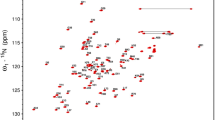Abstract
Translation initiation factor 3 (IF3) is one of the three protein factors that bind to the small ribosomal subunit and it is required for the initiation of protein biosynthesis in bacteria. IF3 contains two independent domains, N- and C-terminal domains, which are connected by a lysine-rich interdomain linker. IF3 undergoes large-scale movements and conformational changes upon binding to the 30S subunit and also during the functional regulation of initiation. However, the precise dynamic interplay of the two domains and the molecular mechanism of IF3 is not well understood. A high-resolution 3D structure of a complete IF3 in bacteria has not been solved. Pseudomonas aeruginosa, a gram-negative opportunistic pathogen, is a primary cause of nosocomial infections in humans. Here we report the NMR chemical shift assignments of IF3 from P. aeruginosa as the first step toward NMR structure determination and interaction studies. Secondary structure analyses deduced from the NMR chemical shift data identified nine β-strands and four α-helices arranged in the sequential order β1-β2-α1-β3-β4-α2-β5-α3-β6-α4-β7-β8-β9.


Similar content being viewed by others
References
Biou V, Shu F, Ramakrishnan V (1995) X-ray crystallography shows that translational initiation factor IF3 consists of two compact alpha/beta domains linked by an alpha-helix. EMBO J 14(16):4056–4064
Chandrasekaran R, Mac Aogáin M, Chalmers JD, Elborn SJ, Chotirmall SH (2018) Geographic variation in the aetiology, epidemiology and microbiology of bronchiectasis. BMC Pulm Med 18(1):1–14
Davies G, Wells AU, Doffman S, Watanabe S, Wilson R (2006) The effect of Pseudomonas aeruginosa on pulmonary function in patients with bronchiectasis. Eur Respir J 28(5):974–979
Fabbretti A, Pon CL, Hennelly SP, Hill WE, Lodmell JS, Gualerzi CO (2007) The real-time path of translation factor IF3 onto and off the ribosome. Mol Cell 25:285–296
Garcia C, Fortier PL, Blanquet S, Lallemand JY, Dardel F (1995a) Solution structure of the ribosome-binding domain of E. coli translation initiation factor IF3. Homology with the U1A protein of the eukaryotic spliceosome. J Mol Biol 254(2):247–259
Garcia C, Fortier PL, Blanquet S, Lallemand JY, Dardel F (1995b) 1H and 15N resonance assignments and structure of the N-terminal domain of Escherichia coli initiation factor 3. Eur J Biochem 228(2):395–402
Goyal A, Belardinelli R, Rodnina MV (2017) Non-canonical binding site for bacterial initiation factor 3 on the large ribosomal subunit. Cell Rep 20:3113–3122
Hirsch EB, Tam VH (2010) Impact of multidrug-resistant Pseudomonas aeruginosa infection on patient outcomes. Expert Rev Pharmacoecon Outcomes Res 10:441–451
Hu Y, Keniry M, Palmer SO, Bullard JM (2016) Discovery and analysis of natural-product compounds inhibiting protein synthesis in Pseudomonas aeruginosa. Antimicrob Agents Chemother 60(8):4820–4829. https://doi.org/10.1128/AAC.00800-16
Hussain T, Llacer JL, Wimberly BT, Kieft JS, Ramakrishnan V (2016) Large-scale movements of IF3 and tRNA during bacterial translation initiation. Cell 167:133–144
Loebinger MR, Wells AU, Hansell DM, Chinyanganya N, Devaraj A, Meister M et al (2009) Mortality in bronchiectasis: a long-term study assessing the factors influencing survival. Eur Respir J 34(4):843–849
Nakamoto JA, Spurio R, Konevega AL, Fabbretti A, Milón P (2019) The complete, functional and 1 dynamic cycle of the bacterial initiation factor 3. bioRxiv. https://doi.org/10.1101/579326
Palmer SO, Hu Y, Keniry M, Bullard JM (2017) Identification of chemical compounds that inhibit protein synthesis in Pseudomonas aeruginosa. SLAS Discov 22(6):775–782. https://doi.org/10.1177/1087057116679591
Petrelli D, LaTeana A, Garofalo C, Spurio R, Pon CL, Gualerzi CO (2001) Translation initiation factor IF3: two domains, five functions, one mechanism? EMBO J 20(16):4560–4569
Shen Y, Delaglio F, Cornilescu G, Bax A (2009) Talos+: a hybrid method for predicting protein backbone torsion angle from NMR chemical shifts. J Biomol NMR 44:213–223
Sivashanmugam A, Murray V, Cui C, Zhang Y, Wang J, Li Q (2009) Practical protocols for production of very high yields of recombinant proteins using Escherichia coli. Protein Sci 18(5):936–948
Zamacona R, Chavero PN, Medellin E, Hu Y, Hughes CA, Quach N, Keniry M, Bullard JM (2018) Identification and characterization of chemical compounds that inhibit leucyl-tRNA synthetase from Pseudomonas aeruginosa. Curr Drug Discov Technol. https://doi.org/10.2174/1570163815666180808095600
Acknowledgements
We would like to thank Drs. Dmitri Ivanov and Kristin E. Cano for technical support and help with NMR experiments at UTHSCSA, Mr. Thomas Eubanks for NMR technical support at UTRGV. This work was supported in part by grants from National Institutes of Health (NIH) (5SC3GM098173-07) and a University of Texas Rio Grande Valley Internal Seed Research Program award. The Department of Chemistry at UTRGV is grateful for the generous support provided by a Departmental Grant from the Robert A. Welch Foundation (Grant No. BX-0048).
Author information
Authors and Affiliations
Corresponding author
Ethics declarations
Conflict of interest
The authors declare that they have no conflict of interest.
Ethical approval
The experiments comply with the current laws of the country in which they were performed.
Additional information
Publisher's Note
Springer Nature remains neutral with regard to jurisdictional claims in published maps and institutional affiliations.
Rights and permissions
About this article
Cite this article
Li, L., Palmer, S.O., Gomez, E.A. et al. 1H, 13C and 15N resonance assignments of translation initiation factor 3 from Pseudomonas aeruginosa. Biomol NMR Assign 14, 93–97 (2020). https://doi.org/10.1007/s12104-020-09926-x
Received:
Accepted:
Published:
Issue Date:
DOI: https://doi.org/10.1007/s12104-020-09926-x




